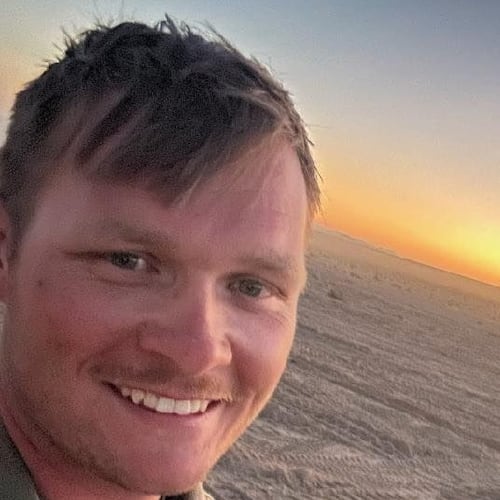Peachtree Corners Councilman Joe Sawyer immediately connected on an emotional level with the families of those killed or wounded in Wednesday’s shooting in a busy Midtown medical facility.
Last November, Sawyer’s daughter, Lauren Sawyer-Allen, 31, was shot and killed while working as a ride-share driver.
The intended target was her passenger, someone she had never met until that ride.
“The grieving process, man, it’s a day-to-day thing,” said Sawyer, who wasn’t able to return to to work at his carpet cleaning business for two months after his daughter was murdered. It took his wife, Kim, three months to return to work as a barber.
While the circumstances of Sawyer’s loss was different, his grief is the same as what victims of Wednesday’s Midtown shooting will face now.
Experts say those affected by the shooting — both victims and their families — will likely go through a range of emotions such as grief, anxiety, depression, anger, fear and confusion about why the violence happened to them.
Wednesday’s shooting at a Midtown medical building left one dead and four others wounded. Amy St. Pierre, 38, died on the scene, leaving behind two children. In a statement, her family noted the outpouring of tears, love and support from her friends, calling them “beyond measure.”
Dr. Robert Jansen , chief medical officer for Grady Health System, addressed that issue in a press conference Friday as he gave an update on victims of the shooting and the fact that one was going home.
“The trauma from a gunshot wound is not just physical, it’s psychological and emotional and I don’t think you can underestimate that impact,” he said.
“I mean, it’s hard to go from a normal life to suddenly have something like this happen at work and you have to deal with that. And so the post-traumatic stress is real and it’s going to impact all of them and we know that.”
The trauma won’t be limited to survivors and their families, however.
Witnesses and co-workers may exhibit signs of trauma and even grief in the next few days, weeks and months. Perhaps even longer.
“I immediately thought that every employee who works in the building will need some form of support,” said Teela Jackson, vice president of Talent Connections, an Atlanta-based human resources consulting firm. “Not only did someone pass away in their workplace, but there may be trauma walking into that building again. They may still hear those gunshots.”
Her firm at times has worked with companies on how to address workplace trauma, as well as more routine needs surrounding grief and mental health issues among employees. In the aftermath of workplace violence, Jackson said employers should make counseling available to workers who request it. It can be offered through an employee assistance program or bringing in outside therapists.
At the CDC, which is based in Atlanta, employee counseling is provided through the employee assistance program. The confidential service is provided by the CDC for those who feel they need help managing personal or professional problems that might be affecting their health and well-being, whether on or off the job.
According to Department of Labor’s Bureau of Labor Statistics, 20,050 workers in the private industry experienced trauma from nonfatal workplace violence in 2020.
In the days after an event like the Midtown shooting, increased anxiety and fear of another violent incident in a work setting can be felt throughout the community.
It’s not the first time Atlanta has experienced this.
In 1999 nine people were shot and killed by a colleague at two day-trading firms in Atlanta. The shooter, Mark O. Barton, had earlier killed his wife and children and committed suicide before he could be caught by police.
In 2005, Brian Nichols, who was being tried on rape charges at a courthouse in Atlanta, shot and killed a judge, courtroom reporter and deputy.
And in 2014 a 19-year-old FedEx worker, Geddy Kramer, shot six people at a facility in Kennesaw before killing himself.
Dorie Griggs serves as chaplain for metro Atlanta hospital and fire departments.
Sometimes, she’s on the scene of a tragedy within an hour of someone learning a loved one has died, whether by accident, natural causes or homicide. She said she’s seen reactions ranging from highly emotional to completely shut down.
“Grief is not clear cut for everyone,” she said. “People think grief is a straight line but it’s actually a scribble. ... It’s very messy.”
Shawn Garrison, director of counseling services at Morehouse School of Medicine and a licensed clinical psychologist, said traumatic events can result in grief. Grief is a reaction to a loss, she said, and trauma is a reaction to a threat to life or safety.
For relatives of the woman who died, Garrison said the expected reaction is shock resulting from the trauma of what happened and how it happened — then grief.
“After the event, there’s shock, sadness and mourning, which is what you’re supposed to feel when something huge like this happens. Your brain is trying to make space for what happened.”
Grief is a dynamic process of realizing the person is no longer with you, necessitating a creation of a “new normal.”
The new normal is difficult for the Sawyers.
He still cries when he sees his daughter’s face mirrored in his grandchildren’s.
He went to counseling once, but hasn’t had time to return because he and his wife are now raising his daughter’s three children. There’s no time, he said, to sit and talk with anyone although he knows he should.
Although he’s a minister, Sawyer doesn’t forgive or have sympathy for the shooter, who was later killed by police.
As for the family of St. Pierre, “They’ll have a hole in their hearts for the rest of their lives,” Sawyer said sadly. “We made it this far though the grace of God.”
And he has a message for all the victims and their families.
“If they want to talk with me, I’m here,” he said. “It’s going to be a hard process.”
About the Author
Keep Reading
The Latest
Featured


